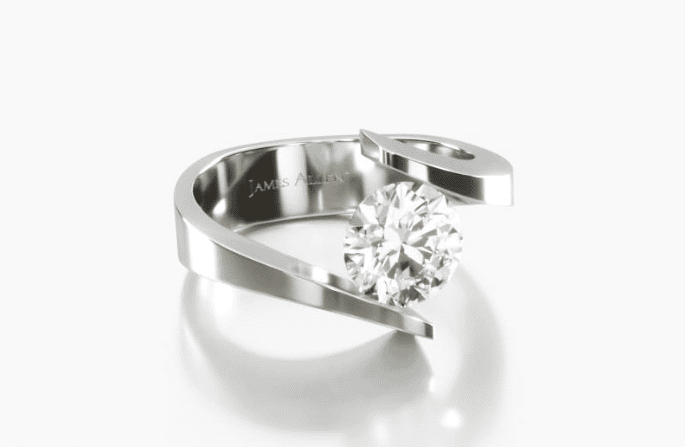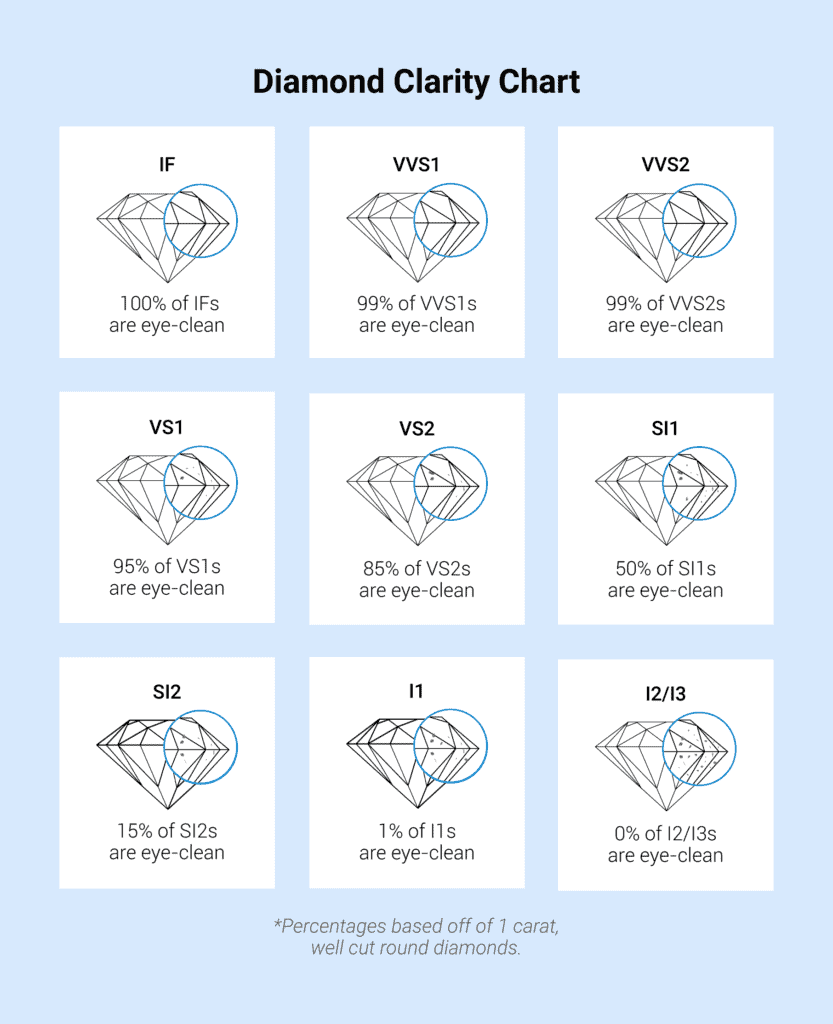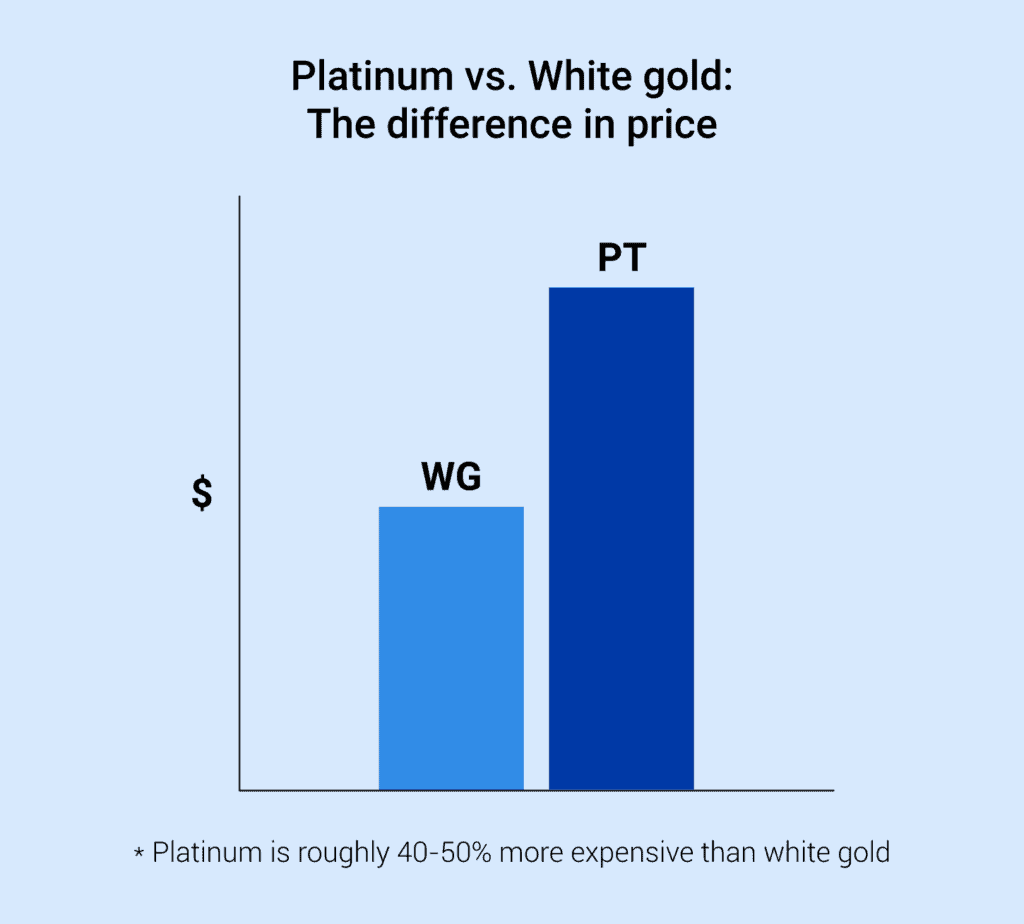Another day, another question. This time, one of our readers has reached out to us asking about a round cut diamond for a tension setting. It doesn’t happen every day that people want a tension-style engagement ring. But if they decide to go that route, selecting a diamond needs special care. So let’s dive into the specifics of how to do it and what is important.
Here’s the reader’s original email:
Hello- I’m looking to purchase a diamond for a platinum engagement setting. The ring is a “tension” style on the James Allen site, sku 11016P. (!! Note: this setting is no longer available on James Allen. You’ll find a picture of it below for reference.) I’m looking for a round stone over 1 carat, ideal cut, eye-clean, and probably an H color. My budget for the stone is around 7 to 8K US, but could possibly bump that if needed for an especially good find in a larger size. Would love to get a few recommendations from you, thanks!
Kudos on a very informative and helpful website!

What is a Tension Setting?
A tension setting is a unique and modern type of ring setting that uses the metal’s tension to secure the diamond in place. Instead of traditional prongs (usually four or six) or bezels, the diamond appears to be suspended between the two sides of the band. This creates an illusion of the stone floating in mid-air, offering an unobstructed view of the diamond and maximizing its brilliance.

As you can see in the picture above, in some types of a tension setting, there isn’t much that holds the diamond in place. The engineering behind tension settings is highly precise, requiring exact measurements and expert craftsmanship to ensure the diamond is securely held. This type of setting not only highlights the beauty of the diamond but also provides a sleek, contemporary look that stands out from more traditional ring styles.
Because the diamond is so exposed in it, this setting requires a precise cut and high-quality diamond to ensure both the security of the stone and its aesthetic appeal.
How to Choose a Diamond for a Tension Setting
Here are some tips and tricks for choosing the best diamond for a tension setting:
Importance of Clarity
When selecting a diamond for a tension setting, clarity becomes particularly important. Because the diamond is more exposed and lacks prongs that can hide inclusions on the edges, it’s crucial to choose a stone with as fewer inclusions as possible. This means that the diamond’s eye-cleanliness (i.e. a diamond that has no inclusions visible to the naked eye) is more important than ever.
For your budget, aiming for a VS1 clarity grade or higher will likely yield a diamond that is both beautiful and free from noticeable imperfections. Sometimes, you could get away with a lower clarity, however, you need to be extra careful.

Ideal Cut
The cut of the diamond is the most critical factor affecting its brilliance. An ideal cut maximizes the light performance, ensuring that the diamond’s brilliance is visible from every angle. Given that the tension setting showcases the diamond prominently, investing in an excellent cut is well worth it.
Color Considerations
For a platinum setting, an H color diamond is an excellent choice. Platinum’s white hue complements the hardly noticeable warm tones of an H color diamond, ensuring that the stone appears bright and colorless to the naked eye.
Carat Weight
The cost of a tension setting can be anywhere from $500 to $3,000 and more. Firstly, choose the type you like. Secondly, search for the largest diamond within your budget. In this case, the reader’s budget allowed him for a diamond over 1 carat, which is a great size for a tension setting as it provides a striking focal point. A diamond like this 1.20ct H color VVS1 clarity round cut would look absolutely perfect.
Platinum vs. White Gold Rings
Our reader also asked if buying the ring in platinum was a good choice. When choosing between platinum and white gold for your ring setting, it’s essential to consider the differences in durability, maintenance, and cost.
Durability
Platinum is denser and more durable than white gold, making it an excellent choice for a tension setting where the metal must securely hold the diamond. Platinum’s strength provides peace of mind that the setting will keep the diamond safe over time.
However, white gold will do as good of a job as platinum and look almost identical. Choose the metal you like the most knowing that both will be secure and durable for a long time.
Maintenance
Platinum tends to develop a patina over time, which some people appreciate for its antique look. However, most people want to keep the shiny look as long as possible. This means that you should have it polished every few years. White gold is typically alloyed with other metals and plated with rhodium to achieve its white color. Over time, the rhodium plating may wear off, requiring re-plating to maintain its appearance. All in all, both metals need some care if worn daily which makes them pretty equal.
Cost
White gold is a more budget-friendly option for engagement rings compared to platinum. Platinum’s rarity, density, and crafting complexity make it significantly more expensive. We are big fans of white gold for keeping the engagement ring budget down. But if someone prefers platinum, there is nothing wrong about that. Our reader wanted a platinum ring which was absolutely OK.

Conclusion
Selecting a round cut diamond for a platinum tension setting involves careful consideration of clarity, cut, color, and carat weight. With your budget, you can find a stunning diamond that meets your criteria and enhances the beauty of the unique setting. By prioritizing an excellent cut and high clarity, you’ll ensure the diamond’s brilliance and good integrity.
Our reader wanted to purchase from James Allen and we definitely recommend exploring the selection they have. They offer high-quality diamonds with detailed images and certifications to help you make an informed choice.
If you need assistance with your tension-setting purchase, feel free to reach out to us. We’re happy to help with that or anything else you need for your engagement ring search.

- No questions asked returns within 30 days of shipment. James Allen will send you a paid shipping label to return the ring.
- Lifetime Warranty
- Free International Shipping
- Free prong tightening, repolishing, rhodium plating and cleaning every 6 months
- Provide insurance appraisals
- One free resizing within 60 days of purchase
- Free ring inscriptions
- Best-in-class high quality imagery of all diamonds in stock
- 24/7 Customer Service
- Best-in-class packaging


- No questions asked returns within 30 days of shipment. Blue Nile will send you a paid shipping label to return the ring.
- Lifetime Warranty
- Free Shipping
- Free prong tightening, repolishing, rhodium plating and cleaning every 6 months
- Provide insurance appraisal
- One free resizing within the first year of purchase
- High quality images of about half of their diamonds
- 24/7 Customer Service
- 100% credit towards future upgrades (must be at least double in value)
- Best in class fulfillment


